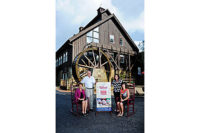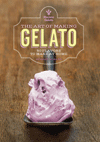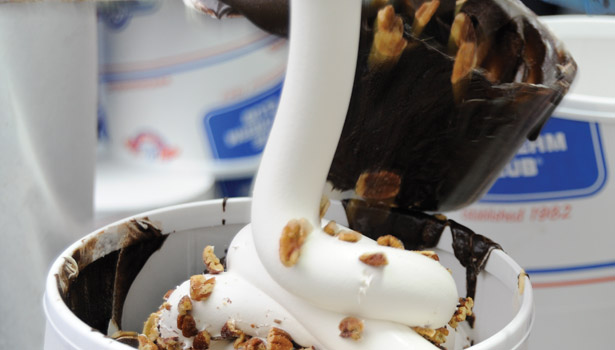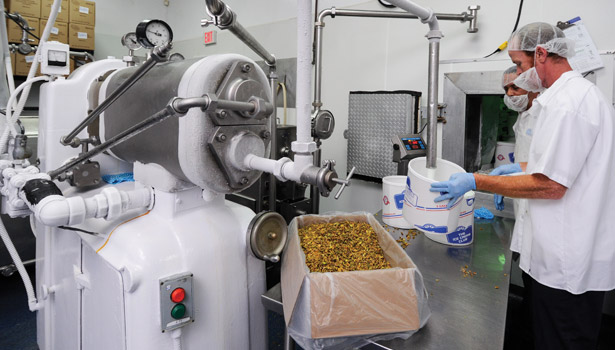This artisan premium ice cream maker uses old-fashioned production techniques
While it has invested in modern processing equipment, it uses some old-fashioned production techniques, like hand ladling.

After a tub is filled, a lid is added and the carton will be weighed before it’s conveyed to a hardening room.

At The Ice Cream Club, ice cream flows from the freezer into a 3-gallon tub and Jim Cummins (left) and Coleman Kelleher add nuts and fudge sauce. Ricardo Santiago sends cartons into the blast freezer.

The 10,000-square-foot warehouse has two truck bays. Company truck drivers make deliveries every day. Pablo Martinez and Jose Silverio move pallets in the freezer.

Damien Thomas adds flavor to ice cream mix in one of the three flavor vats.

Ice cream flows from the freezer to a 3-gallon tub. Nuts and sauces will be added by hand.





When an ice cream processor tells me, “We do things a little differently than most,” I think to myself, “That’s what they all say.” True, most dairies do create unique recipes and flavors, but it still comes down to processing, filling and packaging, and how many variations on those themes can there be?
Meet The Ice Cream Club of Boynton Beach, Fla.
“Come on,” said Co-Founder and Senior Vice President Tom Jackson. “We’re starting to fill.”
He dragged me onto the production floor where four men are crowded around a filler. One placed 3-gallon containers on a stainless steel table. As butter pecan ice cream flowed continuously from the freezer into the tub, another man threw handfuls of fudge-covered pecans into the container while another ladled and stirred fudge sauce into it. The fourth man grabbed the filled tub, slapped a lid on it, wiped it clean, weighed it and shoved it on a conveyor leading to the hardening room.
The process took about 10 seconds and was repeated 110 times. (“For us, that’s a big run,” Jackson said.) That’s how The Ice Cream Club produces Mackinac Turtle Fudge. Then the men wiped down the table and moved on to making pistachio ice cream.
They add nuts by hand rather than using a fruit feeder so they don’t have to shut down the line and clean every time a recipe calls for an allergen (like nuts), Jackson explained. The crew has 75 years of experience between them, estimated Co-Founder and Chief Executive Officer Richard Draper as he watched one man fiddle with a dial on the freezer to regulate the amount of air in the line.
Draper and Jackson don’t order cuttings of packages this size, but they know the ice cream is made right because their employees have been doing this for years. They know the inclusions and ribbons are distributed thoroughly and that the 3-gallon tubs are filled to the correct weight. “There is an art to hand ladling,” Jackson said.
Tom Jackson and Rich Draper were fraternity brothers at the University of Illinois. They ended up in Florida with a vague notion of going into business together. They thought about opening a candy shop or a cookie store before deciding to make ice cream. In 1982, they opened The Ice Cream Club in Manalapan. (See related article "Welcome to the Ice Cream Club.")
With an ice cream freezer they bought at the National Restaurant Show in Chicago, they made two tubs at a time in the back of the shop by night and scooped it into cones and cups by day. They offered 16 flavors initially, and then added more flavors, created from their imaginations and with help from their flavor suppliers. “Garbage Can” (vanilla ice cream with seven candy bars and granulated peanuts) was inspired by a sandwich shop in Champaign, Ill., that offered hot dogs with everything on them, Jackson said.
Draper and Jackson added more scoop shops in the area until they reached a point where they had to decide whether to be a retailer or a wholesaler. They decided to go the wholesale route and bought a larger facility in 1992. Now the owners are at the point where they need more frozen storage capacity in order to grow further. They are looking at sites for a distribution center. A location in northern Florida would help them service customers in the Carolinas and Georgia and to move up the East Coast. The Ice Cream Club has customers as far west as Texas and as far north as Rhode Island.
Scoop shops, restaurants and retirement communities make up The Ice Cream Club’s customer base. The dairy processor offers 176 flavors of ice cream, hard packed yogurt and no-sugar-added, reduced-fat ice cream, most of which are not found in grocery stores. The company also makes 10% and 14% butterfat ice cream mixes, and 70 soft-serve yogurt and ice cream mixes. Customers order the mixes in 2.5-gallon and 5-gallon bags and 300 gallon totes. When the company’s web-based mail order business launches this year, it will be selling pints.
The Ice Cream Club processes ice cream mix on Mondays, Wednesdays and Fridays. The processing room is cleaned on Tuesdays, Thursdays and Saturdays. Working from 5 a.m. to 6 p.m., the crew can make 12 batches a day.
rBST-free cream arrives from a local source in 300-gallon totes. An agitator stirs up the milk solids and the cream is pumped into the two 600-gallon vat pasteurizers. It is heated to 160 degrees for 30 minutes. Jackson said vat pasteurization gives the cream a better flavor than using the faster high-temperature/short time process. After pasteurization, the mix flows through the homogenizer and plate cooler into the holding tanks.
The processing room also has a liquefier for blending liquid ingredients with dry ingredients like milk powders, cocoa and sugar. This room also has a 2.5-gallon bag filler for mixes.
In the filling room are three flavor tanks. The morning that Dairy Foods visited, the tanks contained pistachio, butter pecan and vanilla bases. The company can make 30 flavors a day. Jackson schedules the production. As in most plants, ice creams with the fewest allergens are made first.
A cartoning machine sits in one corner of the filling room. After the 3-gallon cardboard tubs are formed, labels are applied by hand and then an employee stacks the finished tubs on pallets next to the filler.
Cartons of nuts sit in a nearby staging area. Candy bar inclusions have been cut by hand by The Ice Cream Club. Jackson explained that candy bars sold as scoop shop toppings are too small to use as inclusions. Buying whole bars and cutting them on-site allows the ice cream processor to create the bigger chunks it desires.
While the production techniques might seem a little old-fashioned (who hand-ladles fudge sauce anymore?), the food safety practices are as modern as those found in any automated plant. Quality Control Director Maria E. Rodriguez, who oversees plant and product quality, received the Certified Food Scientist designation from the IFT in 2013.
She oversees the on-site lab (“not many companies this size have one,” she said), teaches employees the company’s HACCP procedures and develops the plant’s good manufacturing practices. The lab performs random tests on ice cream for total plate count and coliform. Rodriguez takes four to five ice cream samples daily of work in process and runs organoleptic tests, plate count and coliform on all mixes.
All inbound and outbound trucks are inspected for cleanliness and proper temperature. The temperature of cream totes is taken with calibrated thermometers, and the temperatures in refrigerators and freezers are checked regularly.
The cleaning regimen includes weekly swabbing throughout the plant, including fillers, tables and other surfaces. The concentration of sanitizers is tested and verified. The Dairy Inspection division of the Florida Department of Agriculture and Consumer Services has jurisdiction of the plant. Its inspectors also sample for standard plate count and coliform and calibrate thermometers on the vat pasteurizers.
As their business grew, Draper and Jackson realized they had more to protect. Annual hurricanes, especially the fiercest ones, taught them to be prepared, Draper said. In addition to a preventative maintenance program to keep equipment in service, the owners have invested in redundancies so that the plant never goes down. They also bought back-up generators and a back-up homogenizer. Other recent capital expenditures include a new floor in the processing room and three new 1,000 gallon tanks in the pasteurization room.
“We have worked hard to get where we’re at,” Draper said. “We’ve taken a controlled path” and have not incurred heavy borrowing, he said. Such caution and thrift are old-fashioned values from a modern-day dairy processor that uses ice cream techniques from bygone days. The Ice Cream Club does do things a little differently than most.
The Ice Cream Club
Boynton Beach, Fla.
Year plant opened: 1992
Size of plant: 16,500 square feet
Employees: 46 total, 35 production
Number of production shifts: One
Products made: 176 flavors of ice cream; ice cream mix, frozen yogurt mix
Pasteurization: Two 600-gallon vat pasteurizers
Filling lines: One
Warehouse: 10,000 square feet; two truck bays
Photos by Vito Palmisano
Looking for a reprint of this article?
From high-res PDFs to custom plaques, order your copy today!















